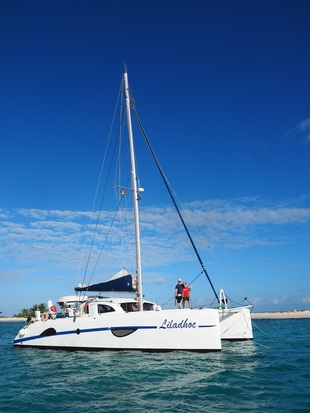ASC caught up with the Horangic family this winter, interviewing Teddy, age 14, Helen, 12, and Basil, 8, after their family’s 15-day Atlantic crossing from Gran Canaria, Spain to St. Lucia. While Teddy and Helen both race small sailboats at home in California, none of them had ever done anything like this. During their passage, they collected two samples for ASC’s Microplastics Project.
 Basil, Teddy and Helen show off their trophy for being the first kids to cross the ARC finish line.
Basil, Teddy and Helen show off their trophy for being the first kids to cross the ARC finish line.
We are living on the boat for a year, and spent the last six months sailing around the Mediterranean, hopping from island to island in the Aegean Sea. From there we sailed to Spain, Gibraltar, Morocco, and finally Grand Canaria, where we spent a week preparing for our Atlantic crossing.
Sailing the big boat has been quite a change. On a dinghy, every movement counts—where you sit is important down to the centimeter, and how you move your body through the waves is essential. Tiny adjustments in sail trim are vital to winning a race. With sailing a yacht, the small details don’t matter as much. In some ways, we don’t feel as much like part of the boat, but more like we are passengers on it.
Helen and Teddy’s school, Castilleja School, and our parents and family members, have encouraged us since we were very young to pursue environmental causes, awareness and action. We had done small projects at home in Palo Alto, California, but decided this trip was an opportunity to take part in bigger, more influential projects.
We took two samples for ASC near the middle of the Atlantic, where it would be hard and expensive to get samples if you were to commission a team of scientists to survey our oceans. We are saving one-liter bottles now so we can continue sampling during the rest of our trip.
The main lesson we took from this project was learning how to conduct an experiment in practice—how to collect samples, and record data with precision.
One aspect of boat life that is difficult is not having classmates. We usually have animated discussions with our friends about global issues, topics, books, etc., and that is something we all really miss.
Our boat is called Liladhoc. It is a 49 feet long, 22 feet wide catamaran.
We all take turns doing watches, and we all know how to do maneuvers like tacking, jibbing, trimming, and anchoring, as well as celestial navigation and doing dishes.
We have a family band. Recently we have been focusing on reggae and taking steel drum lessons from a local player. Basil plays guitar and ukelele, Helen plays bass guitar, Teddy plays drums, steel drums, a little guitar and sings. Our dad plays the guitar and our mom plays the keyboard. We plan to play on the street when we get a little better.
We stopped to do a few man overboard drills during the crossing. They didn’t go as well as we wanted, but we have gotten better since then. There is now a cabbage with a happy face drawn on it in the middle of the Atlantic that we failed to rescue. My mom kept calling it “Wilson.”
The stars were amazing when the moon wasn’t out, and the bioluminescence was stunning. On Thanksgiving we saw three pods of dolphins and a rainbow in one day, which everyone agreed was pretty lucky.
Next we will sail through the Caribbean islands—Tobago, the Grenadines, Dominica, Guadalupe, Martinique, the British Virgin Islands, Antigua, Dominican Republic, Cuba and the Bahamas—and then to Bermuda and finally Canada to see family in Nova Scotia.
We will take as many samples for ASC as we possibly can!


